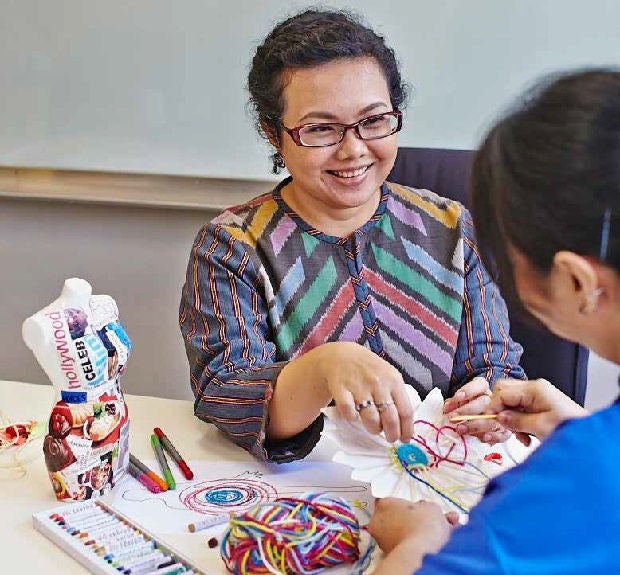
Dian Handayani
Senior Art Therapist, Singapore General Hospital
What is art therapy and what does your role as an art therapist entail?
Art therapy combines psychological therapy with creative expression, allowing patients to express their emotions through art. It provides a medium for them to communicate their concerns and emotions that may not be easily expressed in words.
Artistic expressions can enhance emotional and psychological well-being. Through art, I provide patients with a safe space for them to get in touch with their innate potential, which can be hampered by chronic illness, trauma, disability, or mental illness. The therapy sessions are centred around the patients’ needs, and I hope this helps them rediscover and nurture their possibilities.
What are some of the common myths associated with art therapy?
Some patients are reluctant to try art therapy as they feel that they are not good at art. However, it is not about the artwork they produce, but using art as a resource to understand themselves better. Another common myth is that art therapists are able to read a person’s mind just by looking at his art. I can’t do that because the patients’ interpretation of their own art is personal to them. For instance, the colour red may imply anger for some, but to others, it symbolises love and passion.

Poh Shi Qi
Medical Social Worker, Sengkang General Hospital
What are some of the issues that you help patients and caregivers with?
Patients and caregivers are referred to medical social workers (MSWs) for reasons including psycho-emotional issues stemming from a medical condition (such as diagnosis of cancer), a procedure (such as amputation), or caregiver stress. The sudden onset of a condition can be overwhelming for patients and caregivers. Hence, we pace our patients and journey with them to help alleviate their anxiety.
Patients may feel hopeless at times, and caregiver burnout may surface as a patient’s care needs increase. MSWs assess each case based on various factors, such as the patient’s stage of life, family and community support, financial resources, and the patient’s and caregiver’s coping styles. We then make appropriate recommendations to support them in their care journey.
What are some of the misconceptions about the role of a MSW?
The most common misconception is that MSWs only provide financial assistance — it is but a small part of our work. Another misconception is that MSWs are volunteers and do not require qualifications. In reality, MSWs have to obtain a professional degree in social work before joining this field.

Yasmin Hassan
Senior Clinical Counsellor, Department of Psychological Medicine, KK Women’s and Children’s Hospital
How does a day in the life of a clinical counsellor look like?
The role of a clinical counsellor at KKH is very dynamic. We provide counselling, conduct risk assessments, and offer supportive services to our patients with mental health conditions and their families.
As part of mental health promotion, we conduct emotional health screenings for postnatal mothers. The aim is to identify those at risk of postnatal mental health conditions, and provide early intervention and support services for them.
We also look into case management for our patients. We monitor medication compliance, provide psycho-education, and collaborate with community partners to optimise treatment and support for our patients from tertiary to primary care providers.
How do you deal with patients who may be skeptical about receiving counselling?
It is important to understand what motivates a patient. I always try to uncover my patients’ reservations about undergoing counselling.
I once had a patient who was hesitant about counselling because of a prior negative experience. Exploring what she found helpful and unhelpful, I journeyed with her to build our therapy sessions and allowed her to steer the sessions in ways she felt would be beneficial. By the end of each session, she was looking forward to the next appointment!
There are two key criteria that enable us to build a positive therapeutic relationship with patients: empathy and validation. Understanding experiences from their perspectives and giving them autonomy in deciding what issues to discuss are helpful. Showing care and having a warm presence make the patients feel at ease and willing to share more about their challenges. I believe these factors help create a positive counselling experience for my patients.
Don’t forget self-care!
Here are some tips from our Allied Health Professionals on how you can take charge of your own mental well-being.
Don’t neglect the basics
Eat regular and healthy meals, have sufficient sleep, build physical activity into your routine, and go for your medical appointments.
Take time to recharge
Engaging in simple activities, such as meditation or listening to music, can go a long way in helping you gain mental clarity in your day-to-day life.
Learn to say “no”
We often struggle to say “no” and take on more than we can handle in both our professional and social roles. Learn to set boundaries, inform your supervisor if expectations are unrealistic, and don’t bottle up stress or anxious feelings.
Join support groups
Joining a support group is therapeutic as people in similar circumstances have an opportunity to meet and rally together. You will also be able to exchange tips on how to manage problems that arise.
Express gratitude
Pen a note or send a message to someone you feel thankful for. Expressing gratitude activates the oxytocin system, which is associated with bonding. This leads to stronger connections with others, and in turn enhances your mental well-being.
This story was published in the Special Allied Health Professionals Issue 2021.












 Get it on Google Play
Get it on Google Play